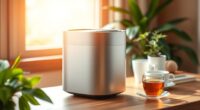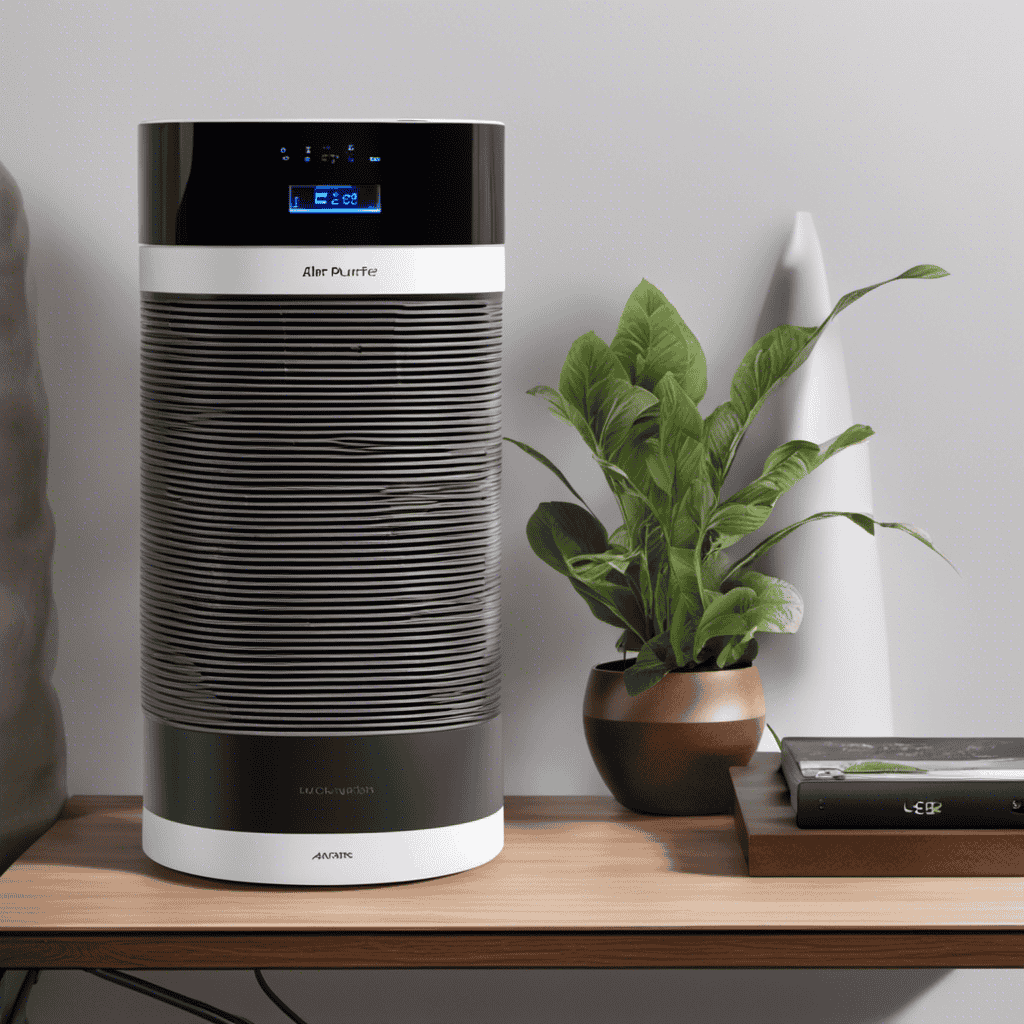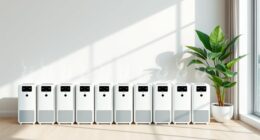Opening windows while running an air purifier can improve ventilation and freshen indoor air, but it also allows outdoor pollutants, pollen, and allergens to enter, which may reduce the purifier’s effectiveness. If outdoor air quality is poor, this can negate some benefits of the purifier. To optimize air quality, consider timing window openings during cleaner hours or using screens. To discover effective ways to balance ventilation and purification, keep exploring these strategies.
Key Takeaways
- Opening windows can introduce outdoor pollutants, which may reduce the air purifier’s effectiveness.
- Ventilating with open windows helps dilute indoor pollutants and refresh indoor air.
- Using air quality sensors can guide optimal timing for window opening to balance airflow and filtration.
- Combining window opening with efficient air purifiers that have HEPA filters can improve overall indoor air quality.
- Timing window opening during low pollution hours minimizes outdoor contaminant entry while enhancing ventilation.
How Air Purifiers Work and Their Limitations
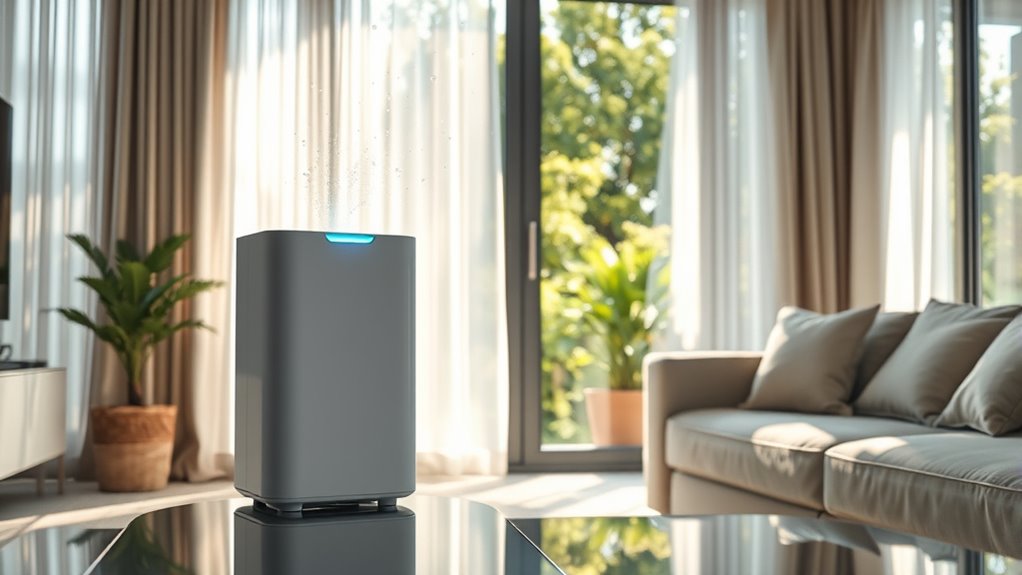
Air purifiers work by drawing in indoor air and passing it through filters that trap pollutants like dust, pollen, pet dander, and airborne bacteria. The core of this process is air purifier technology, which includes HEPA filters, activated carbon, and other specialized media. These filters capture particles, improving air quality. However, filter maintenance is essential; over time, filters become clogged and less effective, requiring regular replacement or cleaning. While air purifiers can considerably reduce indoor pollutants, they have limitations—such as not removing gases or VOCs effectively. Additionally, if you leave windows open, fresh outdoor air can dilute the purifier’s efficiency, making it less effective at removing indoor contaminants. Understanding how these devices work helps you use them most effectively within your home. Research indicates that AI vulnerabilities can also impact the development and safety of air purification technologies, emphasizing the importance of continuous monitoring and safety measures. Moreover, filter quality plays a significant role in the overall effectiveness of your air purifier. Proper ventilation strategies are essential to optimize air quality and ensure your purifier operates efficiently, especially when considering air exchange rates in your living space.
The Benefits of Ventilating With Open Windows
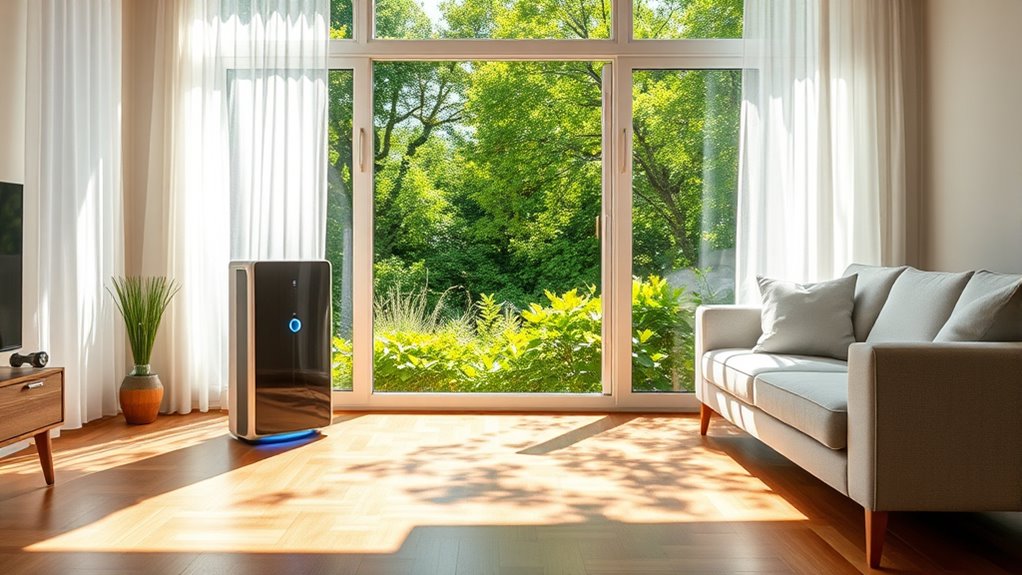
Opening your windows can considerably improve indoor air quality by introducing fresh, outdoor air into your home. This promotes air exchange, helping to dilute indoor pollutants and remove stale air. Ventilation also aids in odor removal, making your space smell fresher and cleaner. When you open windows, you’re actively reducing airborne contaminants and boosting overall comfort. Additionally, natural ventilation can help regulate indoor humidity levels, preventing mold growth and maintaining a healthier environment. To visualize the benefits:
| Benefit | How It Helps | Key Result |
|---|---|---|
| Air exchange | Replaces stale indoor air | Refreshes environment |
| Odor removal | Clears lingering smells | Improves scent |
| Reduced pollutants | Lowers indoor toxins | Healthier home |
Enjoy the natural flow of outdoor air, which complements your air purifier’s efforts and enhances your home’s air quality. Proper ventilation practices are essential for maintaining a healthy indoor environment. Incorporating effective ventilation methods can optimize air quality and reduce reliance on mechanical systems. According to fraud detection techniques, regular updates and real-time monitoring are crucial for effectively managing potential threats to indoor air quality, especially when combined with other preventive measures.
Potential Drawbacks of Opening Windows During Purifier Use
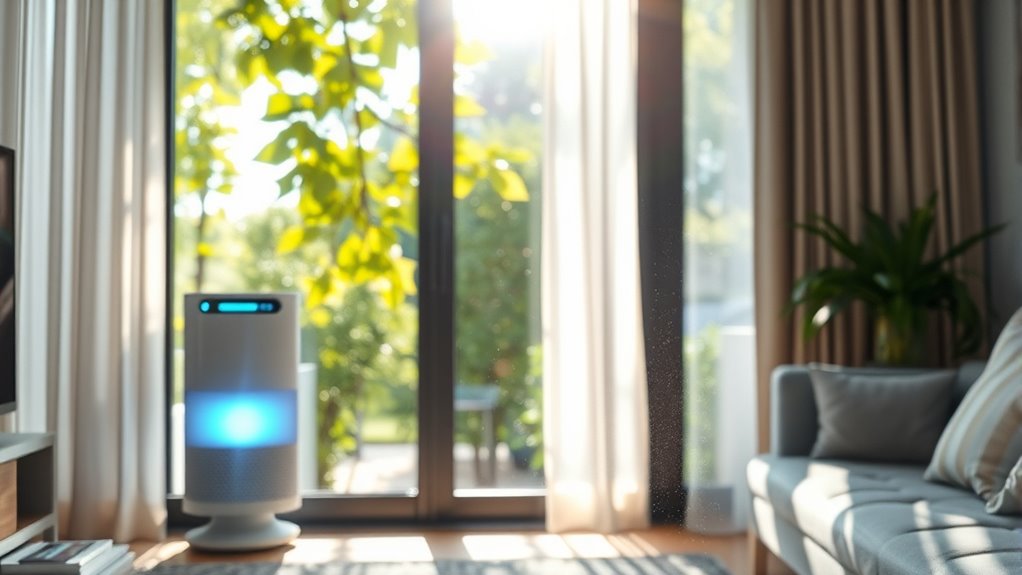
While opening windows can improve indoor air quality, it can also introduce outdoor pollutants, allergens, and humidity that counteract your air purifier’s efforts. These external elements can lower your indoor air quality instead of enhancing it, making it harder for your purifier to maintain a fresh environment. Increased humidity from outside can lead to mold growth and make the air feel damp, reducing indoor freshness. Additionally, pollutants like vehicle emissions, pollen, or dust can enter when windows are open, undermining the purifier’s filtering capabilities. If your goal is to create a cleaner, healthier space, opening windows during purifier use might backfire. You’ll find your efforts to improve indoor air quality are less effective, and maintaining a consistently fresh indoor environment becomes more challenging. Moreover, remote work habits often include creating a controlled environment, which can be compromised by open windows. Considering indoor air quality standards, it’s generally recommended to keep windows closed during air purifier operation to maximize their effectiveness. Opening windows can also disrupt air circulation patterns, making it harder for the purifier to establish a stable and effective airflow within your space. Proper ventilation strategies are essential for maintaining optimal indoor air quality without compromising the purifier’s performance. Incorporating air quality monitoring devices can help you determine when it’s best to open or close windows for optimal results.
How Fresh Air Affects Indoor Air Quality

Opening windows increases ventilation and airflow, helping to clear indoor pollutants. However, outdoor air can also carry pollutants like pollen or vehicle emissions that may worsen indoor air quality. Balancing fresh air intake with indoor air cleanliness is key to maintaining a healthy environment. Utilizing an air purifier can further improve indoor air quality by removing airborne contaminants that enter through open windows. Additionally, understanding air quality monitoring can help determine the best times to open windows for optimal indoor air conditions. Proper ventilation practices can also prevent the buildup of indoor volatile organic compounds, which are common indoor pollutants from household products. Incorporating ventilation technology such as heat recovery ventilators can optimize fresh air intake while conserving energy. Ensuring proper filter maintenance of air purifiers and ventilation systems is essential for their effectiveness in improving indoor air quality.
Ventilation and Airflow
Ever wondered how bringing fresh air into your home impacts indoor air quality? Proper ventilation promotes air exchange, removing stale air and increasing indoor circulation. This process naturally dilutes pollutants, helping your air purifier work more effectively. When you open windows, you introduce new air, which supports continuous airflow and prevents the buildup of indoor contaminants. To visualize how ventilation influences air quality, consider this:
| Ventilation Method | Effect on Indoor Air | Best Use Case |
|---|---|---|
| Natural airflow | Enhances air exchange | During mild weather |
| Mechanical ventilation | Improves indoor circulation | Controlled airflow systems |
| Exhaust fans | Removes odors & moisture | Bathrooms & kitchens |
| Air purifiers + open windows | Boosts overall air quality | Regular fresh air intake |
Balancing airflow helps maintain a healthy indoor environment while your air purifier does its part. Additionally, incorporating ventilation methods can optimize air quality and ensure a safer living space.
Outdoor Pollutant Entry
Bringing fresh outdoor air into your home can improve indoor air quality, but it also risks introducing pollutants from the outside environment. When you open windows, pollutants like pollen, car emissions, and dust can enter, especially if your window insulation isn’t tight. This can challenge your air purifier’s effectiveness, as it has to filter out more contaminants. If you have indoor gardening, opening windows can be beneficial by providing fresh CO2 and helping plants thrive, but it also increases exposure to outdoor pollutants. Consider timing your window openings during low pollution hours or using screens to reduce debris entry. Balancing ventilation with filtration helps maintain healthy indoor air without compromising your indoor environment.
Factors to Consider When Deciding to Open Windows

When deciding whether to open your windows while using an air purifier, it’s important to weigh several factors that can influence indoor air quality. First, consider the outdoor air quality: if pollution levels are high, opening windows can reduce air exchange efficiency and worsen indoor air quality. Second, think about your home’s ventilation needs: opening windows can improve air exchange, but might also introduce pollutants if outdoor air is contaminated. Third, assess your indoor environment: if you’re dealing with allergens or odors, opening windows may help, but it could also bring in new pollutants. Additionally, understanding your air purifier’s filtration capacity can help determine whether opening windows will support or hinder your indoor air quality goals. Proper ventilation techniques, such as timed window opening or using exhaust fans, can optimize air quality without compromising safety. Moreover, being aware of outdoor pollution levels can guide your decision to open or keep windows closed. It is also beneficial to consider the long-term effects of air exchange, as frequent opening of windows may influence indoor pollutant levels over time. For example, indoor air quality management strategies can help you create a healthier environment indoors. Ultimately, you need to balance the benefits of increased air exchange with the risks of outdoor pollutants, ensuring your indoor air quality remains healthy and safe.
Best Practices for Maintaining Clean Indoor Air
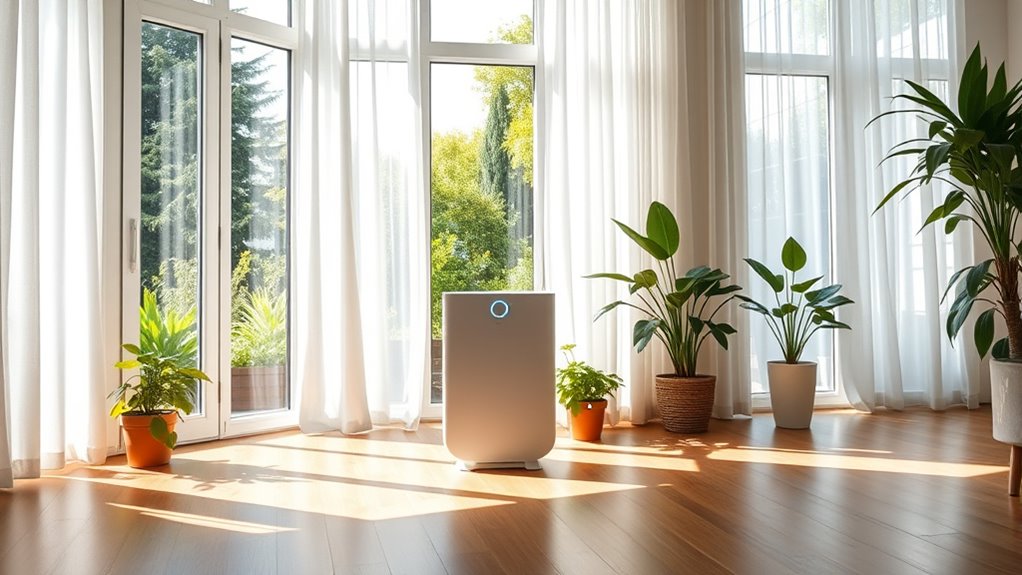
To maintain clean indoor air, implementing effective practices is key. Use air quality sensors to monitor pollutant levels and modify your cleaning or ventilation accordingly. Regularly check and improve air exchange rates to guarantee fresh air circulates without letting pollutants build up. Keep windows closed when indoor pollutants are high or during peak pollution times. Use air purifiers with HEPA filters to remove airborne particles efficiently. Ensure your home has proper ventilation systems for consistent air exchange. Incorporating effective ventilation techniques can further enhance air quality and reduce indoor contaminants. Additionally, understanding indoor air quality can help you make more informed decisions about ventilation and purification strategies. Emphasizing AI-driven solutions in air quality management can lead to more precise and proactive improvements. Properly managing airflow and air circulation is essential for maintaining a healthy indoor environment. Implementing ventilation best practices can significantly improve overall air freshness and safety.
Balancing Air Purification and Ventilation Strategies
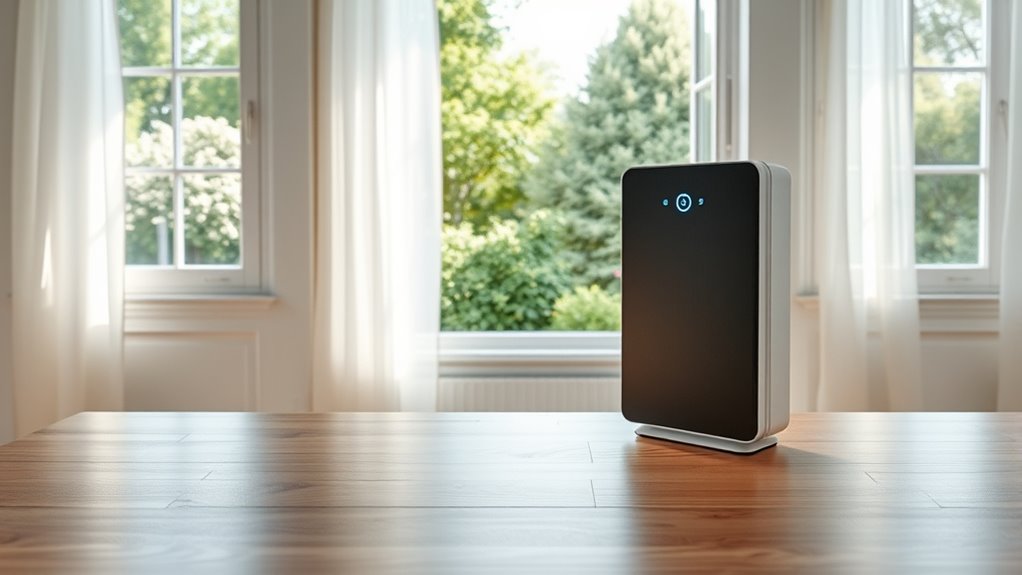
Opening windows can bring in fresh air and improve indoor air quality, but it also risks letting in outdoor pollutants. You need to find a balance so you get the benefits without reintroducing harmful particles. Considering outdoor air quality and your ventilation habits helps you maximize both air purification and fresh air intake.
Fresh Air Benefits
Balancing air purification with proper ventilation is essential for maintaining a healthy indoor environment. Fresh air offers numerous benefits that enhance your space’s quality. First, increasing air exchange helps remove indoor pollutants and stale air, improving overall air freshness. Second, introducing fresh air supports the growth of indoor plants, which naturally filter toxins and boost oxygen levels. Third, proper ventilation reduces humidity and prevents mold buildup, contributing to a healthier atmosphere. By opening windows selectively, you allow fresh air in without disrupting your air purifier’s effectiveness. This balance ensures you enjoy the benefits of cleaner, more oxygen-rich air while minimizing the risk of reintroducing pollutants. Prioritizing both air exchange and purification creates a more comfortable, vibrant living space.
Pollution Re-entry Risks
While opening windows can bring in fresh air and improve indoor air quality, it also introduces the risk of re-entering outdoor pollutants. When you open your windows, outdoor air carries pollutants like vehicle emissions, pollen, and dust that can quickly enter your home. This pollutant entry can counteract the benefits of your air purifier, especially if outdoor air quality is poor. If your neighborhood has high pollution levels, ventilating by opening windows may do more harm than good. To balance fresh air intake with pollution risks, consider timing your window openings during periods of cleaner outdoor air, like early mornings or after rain. Using an air purifier with a fresh air intake feature can also help reduce the chances of outdoor pollutants re-entering your indoor space.
Frequently Asked Questions
Can Opening Windows Improve Air Purifier Effectiveness?
Opening windows can enhance your air purifier’s effectiveness by improving ventilation strategies and increasing air exchange. Fresh air coming in helps dilute indoor pollutants, reducing the purifier’s workload. Just be mindful of outdoor air quality; if it’s polluted or allergenic, opening windows might introduce more contaminants. Balance ventilation with your purifier’s operation to optimize indoor air quality, especially during times when outdoor air is cleaner.
How Does Outdoor Air Pollution Impact Indoor Air Quality?
Imagine outdoor pollution as a dark, swirling cloud creeping into your home, blending with your indoor air. You might think opening windows helps, but it often invites pollutants inside, making your air filtration efforts less effective. Indoor plants can help, but they aren’t enough to combat heavy outdoor pollution. To protect your indoor air quality, keep windows closed on high-pollution days and rely on your air purifier for cleaner, healthier air.
Is It Safe to Open Windows During Allergy Seasons?
During allergy season, opening windows can help improve air circulation, but you should consider window safety and noise considerations. If your windows are secure and you’re comfortable with the noise level, opening them might reduce indoor allergens like pollen. However, if you’re concerned about safety or noise disrupting your peace, keep windows closed and rely on air purifiers instead. Always weigh these factors to protect your health and comfort.
Do Air Purifiers Remove Outdoor Pollutants When Windows Are Open?
Opening windows when using an air purifier is like trying to catch rain with a sieve—outdoor pollutants can easily seep in. While air filtration helps, it can’t fully block outdoor pollutants if windows are open. Indoor plants improve air quality, but they can’t filter everything. To maximize your air purifier’s effectiveness, keep windows closed during high pollution times, especially during allergy seasons or smog alerts.
How Do Weather Conditions Influence Ventilation Decisions?
Weather conditions considerably influence your ventilation choices. High wind speeds can help improve air quality by dispersing indoor pollutants when you open windows, but they may also bring in outdoor pollutants. You should also consider window humidity; opening windows during high humidity can increase indoor moisture, promoting mold growth. To balance fresh air and air quality, monitor wind speed and humidity levels and adjust your ventilation habits accordingly for healthier indoor air.
Conclusion
So, is it okay to open windows while using an air purifier? Absolutely, if you want fresh air and better ventilation. Just remember, opening windows can introduce new pollutants or allergens, which might offset the purifier’s benefits. Think of it like balancing two tools—air purifiers and natural ventilation—to achieve ideal indoor air quality. Are you ready to create a healthier, more comfortable space by combining these strategies effectively?

